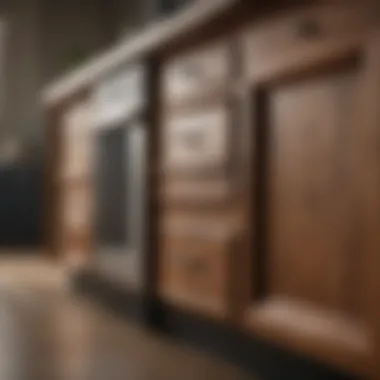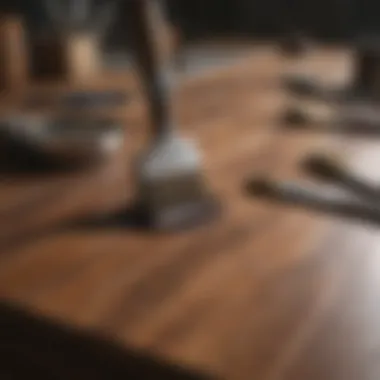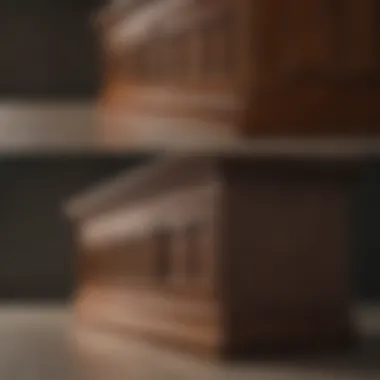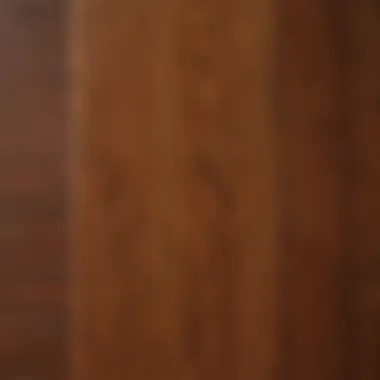DIY Restaining Kitchen Cabinets: A Comprehensive Guide


Intro
Restaining kitchen cabinets is a transformative process that can significantly enhance the aesthetics of your kitchen. It is particularly appealing to homeowners looking to refresh the space without the considerable expense of a full remodel. This guide will delve into the necessary steps, materials, and techniques essential for achieving a professional finish on your cabinets.
The appeal of restaining lies not only in its cost-effectiveness but also in the control it gives you over your kitchen's decor. By selecting the right stain and finish, you can turn tired cabinets into stunning focal points within the room. This guide is tailored for DIY enthusiasts as well as homeowners who might feel overwhelmed by the prospect of undertaking such a project. By breaking down the process and providing detailed insights, readers will have the confidence to take on this rewarding challenge.
Design Inspirations
When embarking on a cabinet restaining project, it is essential to consider design inspirations that align with your style and the overall theme of your kitchen. Choosing the right style and color palette can make a substantial difference in how your space is perceived.
Trending Styles
Currently, several styles are popular among homeowners:
- Modern Minimalism: Clean lines and a focus on neutral colors define this aesthetic. Restaining cabinets in shades like white, soft gray, or even light beige can conform to this trend.
- Rustic Charm: If warmth and a homely feel appeal to you, think about distressing techniques or deeper, richer stains. Dark walnut or deep oak can evoke a sense of coziness and comfort.
- Industrial Edge: For those drawn to a more contemporary look, consider metallic accents combined with dark stains. Black or charcoal gray stains create a striking contrast against metal fixtures.
Color Palettes
Selecting a color palette can feel daunting, but there are effective approaches to make sure the chosen colors work harmoniously:
- Monochromatic Schemes: Using variations of a single color can create a modern and sleek appearance.
- Contrasting Colors: For a bolder statement, choose colors that contrast with your countertops or flooring. This can create visual interest and bring the kitchen to life.
- Natural Shades: Earthy tones often blend well with other elements in the kitchen and create a serene ambiance. Shades of gray, taupe, or even soft moss green are great choices.
Preparation for Restaining
The preparation stage is critical in any DIY project. Properly preparing your cabinets ensures a better bond between the stain and the wood.
- Remove Cabinet Doors: Carefully detach doors and drawer fronts, labeling them for easy reinstallation.
- Clean Surfaces Thoroughly: Use a degreaser to eliminate any grease or grime from the surfaces, as these can prevent the stain from adhering properly.
- Sand the Cabinets: Lightly sand the surfaces to create a textured area for the stain to adhere. This step can also help remove any previous coatings.
- Dust Off: After sanding, ensure all dust is removed. A tack cloth can be used for this purpose.
Proper preparation can significantly enhance the quality of the finished project.
Applying the Stain
The actual staining process involves several detailed steps:
- Choosing the Right Stain: Decide whether you want an oil-based or water-based stain. Oil-based stains typically provide a deeper color, while water-based stains dry faster and have lower toxicity.
- Using the Right Tools: A foam brush or a cloth can be effective for applying stain. Make sure to follow the grain of the wood for a more natural finish.
- Test on a Small Area: Always conduct a test on an inconspicuous area to see how the stain looks once dried.
- Apply Even Coats: Work in controlled areas to ensure even staining. Multiple coats may be necessary for desired depth of color.
Aftercare
After achieving the desired finish, proper maintenance is key:
- Allow for Curing: Follow product guidelines for curing time to ensure durability.
- Avoid Harsh Chemicals: Use mild soap and soft cloths for cleaning to preserve the finish.
Regular checks and gentle care can maintain the beauty of your restained cabinets for years. Taking the time to understand the nuances of the process will empower you to improve your kitchen effectively with dormitory approaches.
Understanding the Importance of Restaining Kitchen Cabinets
Restaining kitchen cabinets is more than a mere aesthetic endeavor; it is a strategic decision that enhances the functionality and style of one of the most essential spaces in a home. Many homeowners overlook the potential that exists within their existing cabinetry. Instead of investing in entirely new cabinets, restaining can be a cost-effective solution that yields stunning results and prolongs the life of these fixtures.
Why Consider Restaining?
There are several compelling reasons to consider restaining your kitchen cabinets. First, the kitchen often serves as the heart of the home. Over time, wear and tear can dull the finish of cabinets, making them appear outdated or worn. Restaining breathes new life into tired wood and can dramatically alter the energy of the space.
Additionally, restaining is an environmentally friendly option. By choosing to restain rather than replace, you reduce waste. It is a sustainable practice that respects the resources used in original manufacturing. This is particularly relevant in a time when eco-conscious choices are becoming more important to homeowners.
Another factor to consider is customization. Restaining allows for a range of colors and finishes that can match changing decor styles as well as personal preferences. Homeowners can take inspiration from current trends or create a personalized style without the financial burden associated with new cabinets.
The Benefits of a Fresh Finish
A fresh finish on kitchen cabinets offers numerous benefits. First, it can increase the overall value of the home. When potential buyers see beautifully finished cabinets, it creates a positive impression, signifying that the home has been well-maintained.
Moreover, restaining can improve kitchen functionality. A refreshed surface can result in easier cleaning and maintenance. Many modern stains are formulated to resist moisture and stains, making them practical for busy households.
Overall, restaining is a practical choice that combines aesthetic appeal with economic sense. The process can be completed with minimal experience and the right tools, giving homeowners a rewarding project to undertake. Proper planning and execution can transform the heart of the home, making it a more inviting and functional space for cooking, gathering, and enjoying.


Assessing Your Kitchen Cabinets
Assessing your kitchen cabinets is a crucial step in the DIY restaining process. Without a proper evaluation, it is easy to overlook key elements that influence the final outcome. The goal here is to understand both the materials and the current state of your cabinets. Knowing these will guide your decisions on preparation and techniques, ensuring a successful project.
Identifying Wood Types
The type of wood your cabinets are made from affects not only the aesthetics but also the absorption of the stain. Some woods, like oak and maple, are more porous and accept stain well. Others, such as cherry, may require a different approach. It is also helpful to identify whether your cabinets are solid wood or a veneer.
- Solid Wood: Offers durability and rich texture.
- Veneer: May require more care when sanding and staining as it is thinner.
To identify the wood type, examine the grain. A closer look can reveal a lot. Light woods often include pine and birch. Dark woods might be mahogany or walnut. This identification is key for your staining choice, as applying certain stains to softwoods may yield different results than applying them to hardwoods.
Evaluating Current Condition
Once you identify the wood type, next is evaluating the condition of your cabinets. Pay attention to scratches, dents, or any areas of peeling paint or laminate. Assessing the surface will inform your preparedness for sanding and treatment.
- Check for Damage: Look for deep scratches or water damage that may need repair.
- Finish Assessment: Determine if the current finish is oil-based or water-based. This will affect how you prepare the surface for restaining.
Key considerations can include:
- The age of the cabinets. Older cabinets may need more extensive sanding.
- The type of finishes already applied. Polyurethane finishes require more extensive prep than lacquered surfaces.
Overall, these assessments provide the foundation for your project. They inform not only the process you will follow but also the tools you will need, ensuring you are well-prepared to undertake this home improvement endeavor.
Gathering Necessary Materials
Gathering the right materials is crucial in the DIY process of restaining kitchen cabinets. The success of your project heavily relies on the quality and appropriateness of the tools, stains, and supplies you choose. Having everything prepared beforehand can streamline your workflow, making the entire endeavor more efficient. It also minimizes the chances of encountering unexpected complications mid-process.
This stage sets the foundation for a professional-looking finish and a satisfying experience. Each element in this phase contributes to the longevity and appearance of the restained cabinets. Thus, understanding the materials will help you make informed choices that align best with your project goals.
Essential Tools and Supplies
The essential tools and supplies needed for restaining kitchen cabinets include:
- Screwdriver: Necessary for removing doors and hardware securely.
- Orbital Sander: This will help you to efficiently sand down the surfaces prior to staining.
- Sandpaper: Various grits are important for achieving a smooth finish. Start with a coarse grit and finish with a finer one.
- Stain Applicators: Foam brushes, rags, or various types of brushes can be used to apply stain evenly on the surface.
- Protective Gear: This includes gloves, goggles, and a mask to protect from dust and fumes.
- Drop Cloths: To cover floors and other surfaces from any potential drips or spills.
Having the right tools ready improves your efficiency while working, ensuring a better final product.
Choosing the Right Stain
Selecting the appropriate stain is a vital step in achieving the desired aesthetic for your cabinets. There are two primary types to consider: oil-based and water-based stains.
Oil-based vs. Water-based Stains
Oil-based stains penetrate deep into the wood, generally providing a richer color and beautiful finish. They offer great durability and are less prone to fading when exposed to sunlight. However, they have longer drying times and produce strong odors during application. This particular aspect makes proper ventilation essential when working with oil-based products. Because of these characteristics, many DIY enthusiasts favor them for projects requiring a deep, warm hue.
In contrast, water-based stains dry faster and have a lower level of volatile organic compounds (VOCs). They are easier to clean up with soap and water, making them a user-friendly option for beginners. However, they may not penetrate the wood as deeply as oil-based stains, which can affect the richness of the color achieved.
The choice between the two often depends on personal preference, project requirements, and environmental factors.
Color Selection Considerations
Color selection is another critical aspect of the staining process. It influences not only the appearance of the cabinets but also the overall mood of the kitchen. Consider the existing color palette of your kitchen and how your chosen stain complements or contrasts those colors. Dark stains can create a rich, elegant look, while lighter stains can brighten the space and make it feel more open.
Keep in mind the grain of the wood as well. Different wood types absorb stain differently, which can impact the final result. Testing stain colors on a small, inconspicuous area before fully committing is wise. This allows you to see how the color looks in different lighting conditions and helps avoid unwanted surprises.
Ultimately, choosing the right stain involves evaluating functionality, aesthetics, and compatibility with your cabinets and personal style. Proper decision-making during this process can lead to a more satisfying restoration and an enhanced kitchen environment.
"The right material selection is as important as the technique in ensuring quality results in any DIY project."
Preparing Your Kitchen
Preparing your kitchen for a restaining project is crucial. Attention to detail during this phase can significantly influence the outcome of your work. It’s not just about having every material at hand but also about creating an environment that promotes efficiency and reduces the risk of damage.
Decluttering and Cleaning


Before starting any restoration work, decluttering is essential. Begin by removing items from cabinets and countertops. This unoccupied space allows for smoother workflow and reduces the likelihood of mishaps. It is also wise to clear surrounding areas of furniture or decor that might get stained or scratched during the process.
Cleaning the surfaces is equally important. Dust, grease, and any residue can interfere with the staining process. A mixture of warm water and mild soap is often sufficient for general cleaning. For tougher grime, consider using a dedicated wood cleaner. Make sure to dry everything thoroughly afterward, as moisture can affect the adherence of the stain.
Protecting Surrounding Areas
Once the kitchen is clean and clutter-free, the next step is protecting areas adjacent to your work zone. It’s essential to safeguard countertops, flooring, and walls from potential stains and scratches. Lay down drop cloths or old sheets to catch any drips or spills. Blue painter’s tape can be used to cover areas where you might not want to apply the stain directly. This includes the edges of walls and windows.
Don’t forget about ventilation. Open windows where possible to allow fresh air to circulate. Stains can emit fumes that must be handled with care. This preparation ensures not only a smoother process but also safe working conditions throughout.
By taking the time to prepare your workspace, you set the stage for a successful and satisfying restaining project.
Step-by-Step Staining Process
The process of staining kitchen cabinets is vital for achieving a polished and renewed appearance. Each step has its importance and contributes significantly to the overall success of the project. Components like preparation and execution require careful attention. If done properly, these efforts can lead to professional-quality results, enhancing the kitchen's aesthetic value. A systematic approach helps to avoid mistakes often made by inexperienced homeowners. By breaking down the process, DIY enthusiasts can follow each phase with clarity, ensuring a smooth transition from old to new.
Removing Cabinet Doors and Hardware
Before beginning any staining work, it is crucial to remove the cabinet doors and hardware. This step prevents unwanted drips on surfaces that might not be stained. To perform this task, first, gather the necessary tools. Common tools needed include a screwdriver and a small container for screws and hardware components. Once you’ve removed the hardware, hang the doors on a sturdy frame or place them flat on a surface covered with a drop cloth. This setup allows you to work more efficiently and reduces the risk of damage to surrounding areas. Taking the time to organize your parts will also simplify reassembly later.
Sanding the Surfaces
Sanding is an essential step that can determine the quality of your finish. This action removes the existing finish and prepares the wood for proper adhesion of the stain. Use a medium-grit sandpaper to start, followed by a fine-grit paper for smoothing. Make sure to sand along the wood grain. Pay attention to corners and edges, as they can trap old finish. Avoid sanding too aggressively, as it can damage the wood. Clean the dust with a cloth or a vacuum to ensure that the surface is free of debris before applying the stain.
Applying the Stain
Adding the stain to the cabinets enhances wood grain and color. It is important to approach this stage methodically. Choose a brush or a cloth, which helps cover surfaces uniformly.
Techniques for Even Application
The technique used for applying stain can decide the outcome greatly. Using a brush often allows for more control and precision. Moreover, applying the stain in the direction of the grain ensures an even coat and reduces the chances of streaks. This technique is popular among professionals because it also allows for better absorption into the wood. On the other hand, cloth application can be quicker and may be suitable for larger areas, but it requires practice to avoid uneven coverage. The main goal is to maintain a consistent look without showing lap marks or splotches.
Drying Times and Considerations
Drying time is a crucial aspect in the staining process. Each type of stain may have different drying times. Factors such as humidity and temperature greatly influence how quickly the stain dries. Typically, oil-based stains take longer than water-based ones. For optimal results, check the product label for specific drying times. Patience is key here, as rushing the process can lead to smudges and imperfections in the finish.
Sealing the Finish
After the stain has properly dried, sealing is the next step. This part protects the wood from damage and enhances the aesthetic appeal.
Choosing a Clear Coat
Selecting the right clear coat is crucial for ensuring durability. Options like polyurethane or lacquer offer varying degrees of protection and finishes. Polyurethane, for instance, provides a tough finish and is widely favored for kitchen cabinets. Meanwhile, lacquer dries quickly but may not offer the same level of durability. Consider your lifestyle and kitchen usage when choosing a clear coat. Matching the sheen to your stain choice is also important for creating a cohesive look.
Application Methods
The method used to apply the clear coat affects the final appearance and performance. Both brushes and sprays are viable options. Brushes allow for more control, particularly in smaller areas, while spraying can cover larger surfaces quickly. Proper technique is important. Apply the clear coat in thin layers to avoid runs and drips. Ensure each layer dries according to the manufacturer's recommendations before applying additional coats. Too much product can lead to a thick finish that diminishes clarity.
Finishing Touches
The finishing touches in a DIY cabinet restaining project are not merely optional; they are essential. These final steps ensure that the hard work put into restoring the cabinets results in a visually appealing and functioning set of cabinets. Attention to detail during this stage can make a significant difference in your overall satisfaction with the finished product. Properly reattaching doors and hardware, along with completing a thorough final inspection, is crucial to achieve the professional appearance you desire.
Reattaching Doors and Hardware
After the staining process is complete and the finish has dried, the next step involves reattaching the cabinet doors and hardware. It is important to do this carefully and methodically. Begin by aligning the doors according to the hinges’ original locations. Use a level to ensure everything hangs correctly. When reattaching hardware, consider using a torque screwdriver. This ensures consistent pressure and avoids over-tightening, which can lead to damage. An organized approach minimizes the potential for mistakes and helps maintain a polished look.
Final Inspection
Inspecting your work before considering the project complete is a necessary step. This is where you can catch any small errors that may have occurred during the project. Check for imperfections, and make sure everything is lined up properly. Addressing small issues now can save time in the long run and can be the difference between a satisfactory result and an exceptional one. A meticulous final inspection reflects your commitment to quality and enhances the overall aesthetics.
Checking for Imperfections
Checking for imperfections is not only practical, it is crucial for ensuring a flawless appearance post-restoration. This step focuses on identifying any uneven tones in the stain, drips, or bubbles that may have formed during the staining application. It is important to use good lighting to reveal details that you might miss under low light conditions. This careful examination ensures that the final look is cohesive and attractive. Addressing imperfections promptly allows for touch-ups that will enhance the overall appeal of the cabinets.


Cleaning Up the Work Area
Cleaning up the work area after completing the project should not be overlooked. This step contributes to the overall success of your DIY project by creating a tidy and organized space. It not only helps in preventing hazards but also prepares the area for future projects. Dispose of used rags, paint cans, and unused materials responsibly. A clean work area reflects your professionalism and dedication to quality results. Being mindful of cleanliness can leave a positive impression that aligns with the quality of work done on the cabinets.
Maintenance and Care for Restained Cabinets
Maintaining and caring for your newly restained kitchen cabinets is crucial to preserving their beauty and longevity. These cabinets have undergone a significant transformation through your hard work and dedication. Therefore, it is essential to be mindful of their upkeep. Proper maintenance not only enhances aesthetics but also protects your investment. Well-cared-for cabinets can endure for years, keeping your kitchen looking its best.
Cleaning Tips
Regular cleaning is a fundamental component in maintaining the finish of your restained cabinets. Here are some effective cleaning strategies:
- Use a Soft Cloth: Always use soft cloths for dusting and cleaning. Avoid abrasive materials that could scratch the surface.
- Mild Cleaning Solutions: A mix of warm water and mild dish soap is usually effective. Dip a cloth in the solution, wring it out, and gently wipe the cabinets.
- Avoid Harsh Chemicals: Strong chemicals can degrade the finish. Always test any new cleaning solution on an inconspicuous area first.
- Dry Immediately: After cleaning, dry the surfaces promptly to prevent water marks.
Establishing a regular cleaning schedule will keep dirt and grease from building up. Aim for a monthly schedule to maintain the pristine condition of your cabinets.
Periodic Touch-ups
Despite your best efforts, wear and tear are inevitable. Over time, your cabinets may require touch-ups to address minor scratches or scuffs. Here’s how to perform periodic touch-ups:
- Inspect Regularly: Make it a habit to inspect your cabinets for any signs of damage, like scratches or areas where the finish is fading.
- Choose the Right Stain: For touch-ups, ensure you have the original stain ready. If it’s been years, you may need to test a small area to see if it matches.
- Apply Sparingly: Use a small brush to apply stain to the damaged area. Avoid over-applying, as it can create uneven patches.
- Blend Edges: Feather the edges to blend the new stain with the existing finish for a seamless look.
- Seal if Necessary: If the touch-up is significant, consider sealing the area again to maintain the protective barrier against moisture and dirt.
Being attentive to the condition of your cabinets will help you avoid larger repairs in the future.
Regular maintenance is the key to extending the life of your restained cabinets.
Common Mistakes to Avoid
Restaining kitchen cabinets can bring new life to your kitchen while also being a rewarding project. However, there are pitfalls that can lead to less-than-ideal results. Understanding these errors can promote a smoother process and a more satisfying finish.
Rushing the Process
One of the grave mistakes people often make is rushing through the restaining process. Whether it’s due to impatience or underestimating the effort required, haste can lead to poor results. The time you spend preparing and applying the stain is crucial.
If you do not allow sufficient drying time, you might end up with uneven color or a sticky finish. Skipping steps, such as sanding the surfaces properly, can result in a finish that does not adhere well. Patience is vital. Make sure to thoroughly plan your time. Include periods for drying and curing in your timeline.
Inadequate Prep Work
Proper preparation work is key for achieving the desired outcome. Inadequate prep can make your project fail before it even starts. This involves several factors, from cleaning the surfaces to removing old finishes. If you do not clean and degrease effectively, the new stain may not bond properly.
A lack of sanding can also cause problems. For optimal adhesion, surfaces should be sanded down to create a smooth area for the stain. Always remember to use the correct grits. For beginning, a coarser grit can help remove the old finish, followed by a finer grit for smoothness.
After prepping, do not forget to remove dust particles that might linger. The last touch in preperation can be the most vital.
"Preparation is the key. Without it, success in restaining is unlikely."
Overall, avoiding these common mistakes ensures a satisfactory final result and enhances the beauty of your kitchen.
Ending: The Value of a DIY Approach
Engaging in the restaining of kitchen cabinets as a DIY project provides significant value. First, it offers a sense of accomplishment upon completing the task. Many homeowners discover that hands-on work fosters not only skill improvement but also a deeper appreciation for their living spaces. Kitchen cabinets transform through restaining, and the process allows you to personalize your environment.
Another notable benefit is cost-effectiveness. Hiring professionals often incurs high expenses. By choosing to do the work yourself, you save labor costs, allowing funds to be allocated toward quality materials or other upgrades in your kitchen. The satisfaction derived from managing the entire process, from planning to execution, cannot be overstated.
However, it is paramount to approach the project with adequate preparation. Understanding the steps involved, gathering the right tools and materials, and learning various techniques will enhance your experience. This leads us into the importance of skill development.
Building Skills Through Practice
Completing a DIY project like restaining cabinets inherently develops various skills. You sharpen your attention to detail as you evaluate the current condition of your cabinets. You learn to handle tools effectively, as well as mastering techniques such as sanding and staining. Through practice, those skills become refined, enabling you to tackle more complex projects in the future.
Additionally, committing to these tasks improves problem-solving abilities. Encountering unforeseen issues—like stubborn stains or uneven surfaces—requires adaptability. You learn to assess problems and determine the best solutions. This resilience is invaluable, transcending the confines of home improvement.
Enhancing Home Aesthetics
Restaining kitchen cabinets greatly impacts the overall aesthetics of your home. The process resurrects tired and worn-out cabinetry, injecting vibrance into the often most visited space in your house. Selecting the right stain color and finish can harmonize with your kitchen’s style and existing elements. This cohesive look does so much for enhancing your home's appeal.
Moreover, this aesthetic improvement goes beyond mere appearances. A well-done cabinet restoration can increase the value of your property. Potential buyers are attracted to homes with updated features, recognizing the effort put into maintaining a modern and appealing environment.
"A carefully executed DIY project not only showcases your personal style but also enhances the market value of your home."
Through restaining, you create a space that reflects your taste and caters to functionality. The confidence gained from working on your cabinets translates into new projects, leading to continuous home improvement. Embrace the DIY approach, and witness your kitchen—and even your home as a whole—flourish.







